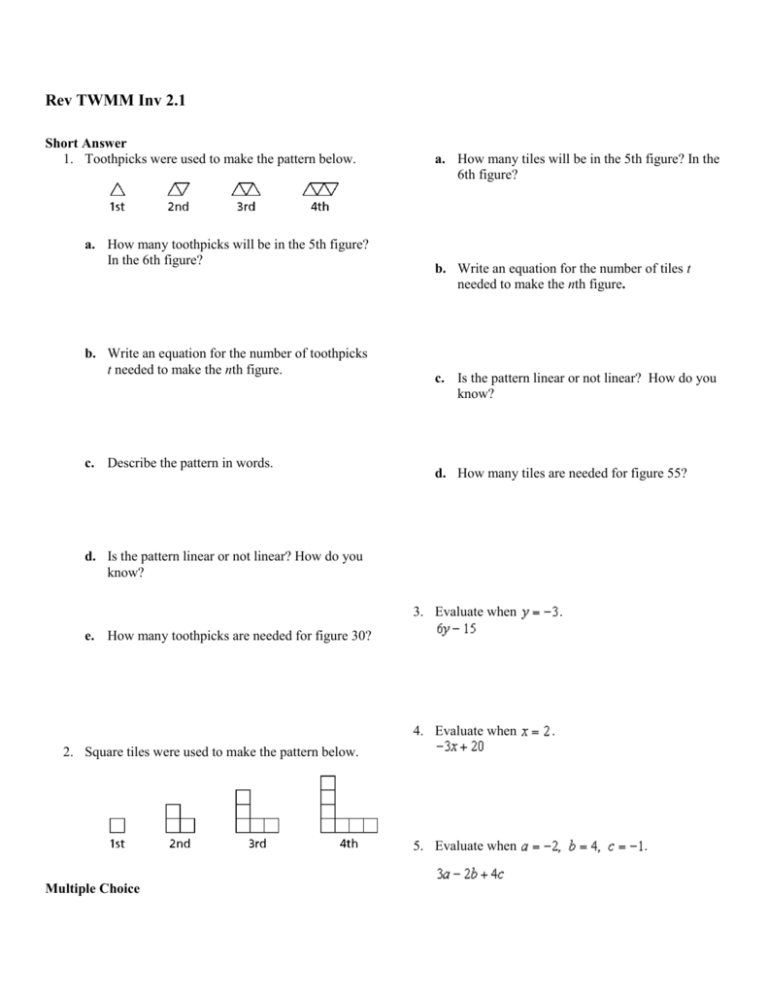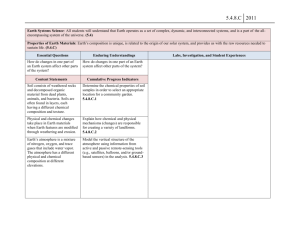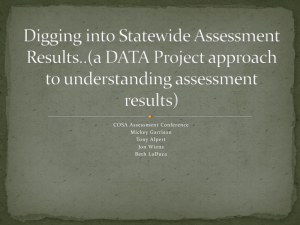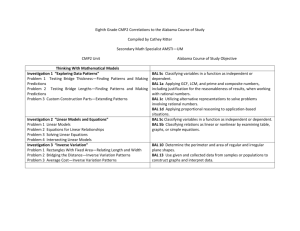Rev TWMM Inv 2.1 Answer Section
advertisement

Rev TWMM Inv 2.1 Short Answer 1. Toothpicks were used to make the pattern below. a. How many toothpicks will be in the 5th figure? In the 6th figure? b. Write an equation for the number of toothpicks t needed to make the nth figure. c. Describe the pattern in words. a. How many tiles will be in the 5th figure? In the 6th figure? b. Write an equation for the number of tiles t needed to make the nth figure. c. Is the pattern linear or not linear? How do you know? d. How many tiles are needed for figure 55? d. Is the pattern linear or not linear? How do you know? 3. Evaluate when . e. How many toothpicks are needed for figure 30? 4. Evaluate when . 2. Square tiles were used to make the pattern below. 5. Evaluate when Multiple Choice . Identify the choice that best completes the statement or answers the question. 6. List the terms that correctly complete the table. Time (sec) 0 Distance (ft) a. 15, 60, 110 1 2 3 30 40 50 b. 20, 60, 110 4 5 6 7 8 70 80 90 100 c. 20, 65, 113 d. 20, 60, 113 7. What is the slope of the line that passes through the points (0, 3) and (8, 4)? a. 3 b. c. d. 8 8. Which of the following equations would best model the data table below? x y a. y = 2x + 1 2 5 3 7 4 9 5 11 b. y = 2x 6 13 7 15 8 17 9 19 c. y = 2x + 5 9 10 21 d. y= Rev TWMM Inv 2.1 Answer Section SHORT ANSWER 1. ANS: a. 11; 13 b. t = 2n + 1 c. To get to stage n from stage n – 1, you need to add two toothpicks to make a new triangle, starting with the first triangle, which uses three toothpicks. OR: At stage n, you need n toothpicks for the top and bottom of the figure and n + 1 toothpicks for the sides. d. The pattern is linear; for each new stage, we add two new toothpicks. The pattern increases by the same number each time. e. 61 PTS: 1 DIF: L2 REF: Thinking with Mathematical Models | Additional Practice Investigation 1 OBJ: Investigation 1: Exploring Data Patterns NAT: NAEP D1a| NAEP D2e STA: 8AL 5a| 8AL GE VII-8 TOP: Problem 1.3 Extending Patterns KEY: graphing | finding patterns | linear models 2. ANS: a. 9; 11 b. t = 2n – 1 c. This is a linear pattern; at every stage, we add two new tiles. d. 109 PTS: REF: OBJ: STA: KEY: 3. ANS: -33 1 DIF: L2 Thinking with Mathematical Models | Additional Practice Investigation 1 Investigation 1: Exploring Data Patterns NAT: NAEP D1a| NAEP D2e 8AL 5a| 8AL GE VII-8 TOP: Problem 1.3 Extending Patterns finding patterns | graphing | linear models PTS: 1 4. ANS: 14 PTS: 1 5. ANS: -18 PTS: 1 MULTIPLE CHOICE 6. ANS: REF: OBJ: STA: KEY: 7. ANS: REF: OBJ: NAT: D2e TOP: 8. ANS: REF: NAT: STA: KEY: B PTS: 1 DIF: L1 Thinking with Mathematical Models | Skills Practice Investigation 1 Investigation 1: Exploring Data Patterns NAT: NAEP D1a| NAEP D2e 8AL 5a| 8AL GE VII-8 TOP: Problem 1.3 Extending Patterns arithmetic sequence | one solution C PTS: 1 DIF: L2 Thinking with Mathematical Models | Multiple Choice Investigation 2: Linear Models and Equations NAEP A1f| NAEP A2b| NAEP A2c| NAEP A2d| NAEP A4a| NAEP A4c| NAEP A4d| NAEP D1a| NAEP STA: 8AL 5d| 8AL 5a| 8AL GE VII-7| 8AL GE VII-8 Problem 2.2 Equations for Linear Relationships KEY: slope A PTS: 1 DIF: L2 Thinking with Mathematical Models | Multiple Choice OBJ: Investigation 3: Inverse Variation NAEP A2a| NAEP A2b| NAEP A3a| NAEP D1a| NAEP D2e 8AL GE VII-8 TOP: Problem 3.3 Inverse Variation Patterns linear models | inverse variation | writing equations







